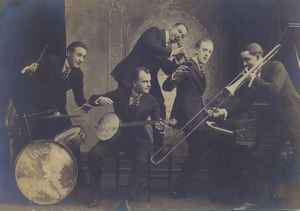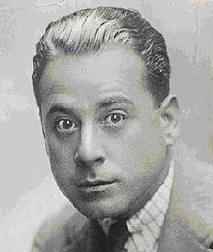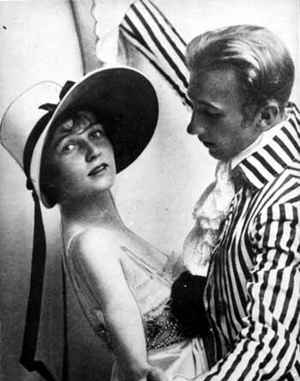


Louisiana Five in the Shadow of the ODJB
Source: Wikimedia Commons
Ballroom dancing had been around since the 16th century, ballet and the jig as well. Come the minuet in the 17th century, popular especially with French nobility, the square dance for folks with barns in England about the same period, that to go country in the US and country western upon the influence of swing. In the latter 18th century Charles III had allowed Spanish gypsies to present flamenco to the general public. In the early 19th century came the waltz as formal dance spread from palaces to the general population [see Johann Strauss I]. The waltz remains widely popular to this day, as well as the tango originating in Argentina at about the same time. But the waltz had not so fervent the popularity as the foxtrot in association with ragtime. The invention of the foxtrot is often credited to vaudeville actor, Harry Fox, as of 1914.

Harry Fox Startled by a Suddenly Brighter Past
Foxtrot Initiator
Source: Wikipedia
The foxtrot was also introduced to the American public by ballroom dancers, Irene and Vernon Castle, about the same time.

Irene & Vernon Castle Frozen Stiff by Light so Bright
Foxtrot Initiators
Source: Ballroom Chick
The foxtrot followed ragtime toward jazz, the later jitterbug to arrive with swing. Major to rock n roll some twenty years after was the twist in the early sixties. Groups like the Original Dixieland Jazz Band (ODJB) and the Louisiana Five were ragtime operations which existed primarily for dancing, in particular the foxtrot (aka One-Step), excepting their early flourishes of jazz added to the popular repertoire of hotels which were beginning to become major venues of music. At this early stage jazz surfaced more as afterthought given a little rein than a genre. "Jazz" was in the air as the ODJB made apparent by its name, and though that was a sprinkle of Dixieland where jazz has its roots, it was not yet raining jazz. People more had dancing on the brain on Saturday nights than listening to wild music. Albeit the ODJB landed numerous titles on the popularity charts the Louisiana Five placed none. Nor is the fame of the Louisiana Five based in its longevity, for it disbanded in 1920. Existing for only a couple of years, the Louisiana Five probable was and is known more for its similarity to the ODJB than itself. It was an "also" to the ODJB that was and remains the main story along that particular avenue bridging ragtime to jazz yet quite early both in development and to the ears of the general public. Tom Lord doesn't list the Louisiana Five in his jazzology at all.
The Louisiana Five originated in New York City with drummer, Anton Lada, its leader. Other members were pianist, Joe Cawley, trombonist, Charlie Panelli, banjoist, Karl Berger and clarinetist, Alcide "Yellow" Nunez, who had briefly performed with the ODJB in 1916 prior to the latter's first recordings in 1917. Interesting to note is a lawsuit brought against Nunez and Ray Lopez in 1917 by Nick LaRocca and the ODJB over 'Livery Stable Blues'. Though Nunez and Lopez had previously copyrighted the melody, it was tossed out of court on grounds that if one couldn't read music, as apparently neither Nunez nor Lopez did, then one couldn't steal a song. Following this curious decision the Louisiana Five scratched their first records in latter 1918 toward issue the next year on Emerson [Alexander]. The Louisiana Five also played as Ben Kelly's Jass Band which became the Frisco Five in January of 1919 and recorded several titles for Emerson from February to circa May of 1919 [Rust].
'A Good Man Is Hard to Find' Louisiana Five
Recorded Dec 1918 in NYC Emerson 9158 / Medallion 847
Composition: Eddie Green
'Alcoholic Blues' Louisiana Five
Recorded 23 June 1919 in NYC Emerson 9158 / Medallion 847
Composition: Albert Von Tilzer
'Clarinet Squawk' Louisiana Five
Recorded 12 Sep 1919 in NYC Matrix 6928 Edison cylinder 3896 / disc 50609
Composition: Anton Lada / Yellow Nuñez / Joe Cawley
'Yelping Hound Blues' Louisiana Five
Recorded 12 Sep 1919 in NYC Matrix 6929 Edison cylinder 3909 / disc 50622
Composition: Anton Lada / Yellow Nuñez / Joe Cawley
'Slow and Easy' Louisiana Five
Recorded 16 Dec 1919 in NYC Columbia A2949
Composition: Russel Robinson / Spencer Williams
'Weary Blues' Louisiana Five
Recorded Jan 1920 in NYC Emerson 10116
Composition: Artie Matthews
'Weeping Willow Blues' Louisiana Five
Recorded Jan 1920 in NYC Emerson 10172
Composition: Robert King
Lada went on to form other bands after the demise of the Louisiana Five, one of which was the Original Louisiana Five in 1924. He made his last recordings in Los Angeles in 1925 with his Louisiana Lads. Living as a popular drummer in NYC, he eventually moved to Los Angeles in 1941, apparently to work in film though there is no mention of him at IMDb. He there died on 28 August 1944.
Nunez played in bands in Chicago for a short time before returning to Louisiana where he'd been born. He there performed with several outfits including the New Orleans police band, dying in New Orleans on 2 September 1934.
Panelli (trombone) moved onward to eventually join the Original Indiana Five (OIF) for a brief time in 1925. The OIF was a later configuration of the briefly existing Indiana Syncopators, of which the Jazz Masters was a pseudonym which Konig has recording 'Bees Knees' on 15 January of 1923 toward issue on Black Swan 2109 with 'Sweet Lovin' Mama' flip side. Titles by the Indiana Syncopators followed on 1 April of 1923 toward release on Olympic. The Indiana Syncopators also issued on La Belle, perhaps from the same matrices as for Black Swan but that's more an imagined notion than founded in sessionography. Be as may, the OIF quickly followed in April if not May, which group issued numerously until the band evaporated in 1929, though reunited occasionally for another twenty years. As Panelli was with the OIF only a short time in 1925 he isn't participant to recordings below.
'Bees Knees' Indiana Syncopators
Recorded 15 Jan 1923 in NYC La Belle 1418
Composition: Ted Lewis / Ray Lopez
'Mean, Mean Mama' Original Indiana Five
Recorded 7 Sep 1923 in NYC Pathe Actuelle 021070 A
Composition: Eleanor Young / Harry Squires / Mitchell Parish
'I'd Rather Be Alone' Original Indiana Five
Recorded 13 Jan 1926 in NYC Harmony 101-H / Velvet Tone 1101-V
Composition: Milton Ager
'Delilah' Original Indiana Five w Tony Pace
Recorded 24 Dec 1926 in NYC Harmony 327-H / Velvet Tone 1327-V
Music: Fred Fisher Lyrics: Billy Rose
Though neither the Louisiana Five nor Original Indiana Five made much noise in comparison to the ODJB, they together well represent the decade of the Roaring Twenties from beginning to end.
Sources & References for the Louisiana Five & Original Indiana Five:
VF History (notes)
Audio of the Louisiana Five: Internet Archive
Audio of the Original Indiana Five: Internet Archive
Band Members: Louisiana Five:
Anton Lada (1890-1944 / drums): Drums in the Twenties Wikipedia
Alcide Nunez (1884-1934 / clarinet)
Charlie Panelli (trombone)
Band Members: Original Indiana Five (transition of personnel):
Recordings by the Jazz Masters: Sessions:
Recordings by the Louisiana Five: Catalogues:
45 Worlds Discogs Edison Blue Amberol RYM
Recordings by the Louisiana Five: Sessions:
Scott Alexander DAHR Brian Rust (also Frisco Five)
Recordings by the Original Indiana Five: Catalogues:
Recordings by the Original Indiana Five: Sessions:
Scott Alexander (also Indiana Syncopators)
Brian Rust (also Indiana Syncopators)
Further Reading:
Dance: Twenties Thirties Sixties
The Tango: Dance Facts Dance Facts
Ragtime:
Library of Congress New World Encyclopedia Wikipedia
Classical Main Menu Modern Recording
hmrproject (at) aol (dot) com